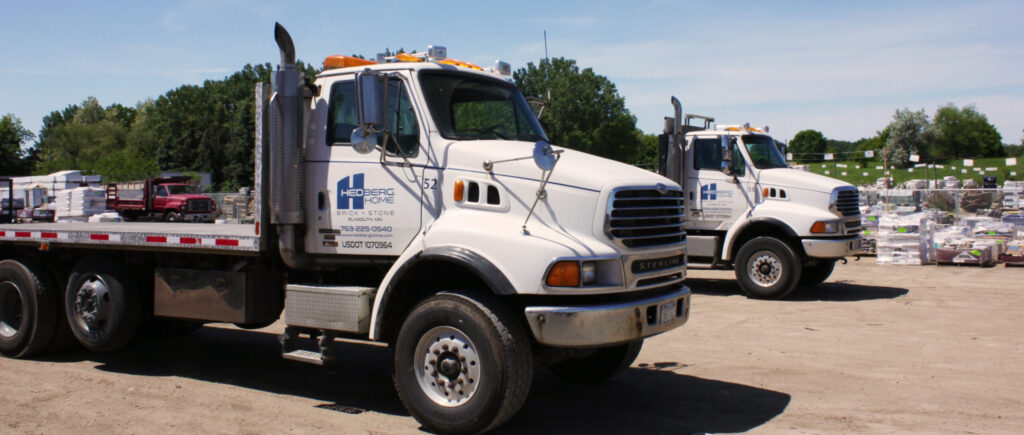- Why do we have spring road restrictions?
- How do Minnesota’s road postings work?
- When do they go into effect? How Do I know?
- How Can Hedberg Help?

Springtime presents delivery challenges in Minnesota and other northern states due to seasonal – or “spring” – road restrictions. At a time of year when we feel it should be getting safer and faster to deliver goods and services, logistical managers, dispatchers, and delivery drivers alike are asked to “hit the brakes” around using certain routes and roadways. If not properly managed, spring conditions combined with heavy traffic can quickly make swiss cheese of our roadways. To avoid fines and crumbling roads, industry pros are challenged to navigate a patchwork of weight-based detours on top of their regular duties.
That’s why Hedberg Home is here to help.
WHy DO We have SPRING Road restrictions?
When the ground in northern climates begins its annual spring cycles of freezing and thawing, serious damage can occur on roads experiencing traffic with too much weight. At this time of year, melting water becomes trapped in the road’s base layers, leading to conditions that cause surface cracking, potholes, and rutting. To avoid these issues, city and state agencies in northern states “post” reduced weight limits on specific roadways that are susceptible to damage.
How do Minnesota’s Road postings work?
To properly navigate the State’s patchwork of restrictions, we first need to know the various agencies involved in managing our roadways. First, the Minnesota Department of Transportation (MnDOT) manages all state and federal highways. Individual counties then manage postings on all County Roads, and cities finally handle any required postings on the roads they maintain. Though these parties tend to post restrictions at similar times, they share information in different places, and their managed roadways and restriction details vary.
As explained by MnDOT:
“Minnesota roadways are generally categorized into two specific groups. The main group consists of all paved highways. These are commonly referred to as 10-ton routes. Road authorities have the option to restrict the weight on these routes to a lower limit, in which case, signs must be “posted” indicating the restricted limit. Unless posted, paved routes remain at 10-ton limits.
Unpaved routes make up the second group and are commonly referred to as 9-ton routes. In the Spring of each year, all unpaved routes are restricted to 10,000 pounds on single axles and 5/9 of the weights specified for unpaved routes in the Gross Weight Table for groups of two or more consecutive axles, unless otherwise posted.”
“Minnesota Weight Laws & limitations”. Pamphlet.Pg1.01.19.2016
MN Counties and Cities follow a similar approach as MnDOT, only for a different list of roadways. The bottom line is that specific roads across the state will have lower weight limits (i.e. 4, 5, 6, 7, 8, or 9 ton maximums) “posted” for a period of time each spring. The challenge then becomes knowing when and how navigate the patchwork of restrictions.
Learn More: Minnesota Weight Laws & Limitations | Restricted Gross Weight Table
When do SPRING ROad Postings go into effect? How Do I know?
Though the type of road, managing agency, and seasonal weather patterns can all impact the exact time roads are posted in a given area, the bulk of spring road restrictions are usually in effect from mid-March to mid-May.
That said, some cities in the West Metro’s lakes region such as Minnetonka, Wayzata, Deephaven, and Orono post their restrictions every year on March 1st. Whereas MnDOT and MN Counties post restrictions based on when they expect the spring thaw to be underway that year. All other Minnesota cities post their city-specific restrictions online as needed.
Government Resources: MnDOT Seasonal Load Limits | MN County Weight Information
As you can imagine, the exact MnDOT, county, and city posting dates depend on the weather patterns for the given year. Warm, early springs see restrictions posted earlier, where cooler, longer springs tend to be posted later – or simply for longer periods in some instances.
How Can Hedberg Help?
No matter how or when a restriction is posted, the Hedberg Home team is here to help keep your projects moving this spring:
- by coordinating early ordering and delivery to jobsite. Work with your sales rep to deliver materials to the jobsite before spring road restrictions are posted.
- by offering extended terms. If you need help bridging the financing gap, we’re happy to offer extended terms to all credit account-holding customers. Sometimes this added flexibility makes all the difference.
- by helping map routes. Hedberg Home’s Order Desk and sales teams are always available to look into addresses, check on road weight limits, review city maps, and figure out solutions to your deliveries.
- by maximizing permitted delivery windows. All cities offer 1-day permits for exceeding these weight limits on certain roads. By sharing 3-5 day’s notice and a copy of your permit with Hedberg, our team can work with you to develop a plan to get your product delivered within the legally permitted window.
- by splitting deliveries into smaller loads. While restrictions are in effect (ex. 4, 5, 7, and 9 ton maximums), we may need to get creative organizing our shipments. If mandated by the available route and freight weight, full orders can be broken into multiple, smaller shipments. In this case, consider having mortar and accessories delivered first to allow for set up, followed by the veneer when your crew is set and ready.
Helping customers develop custom shipping solutions is just one way we meet our simple mission of “helping our customers become more successful.” Contact Us to find out what Hedberg Home can do for you.














